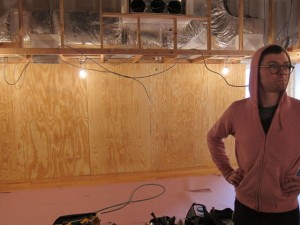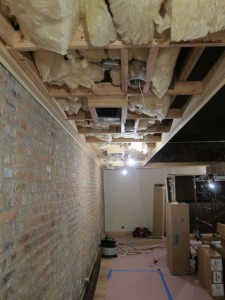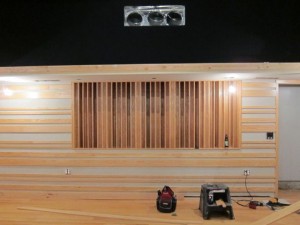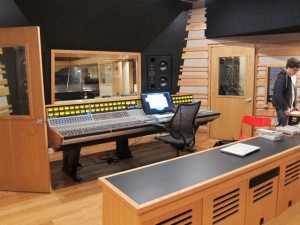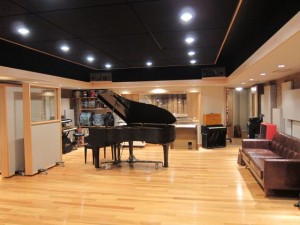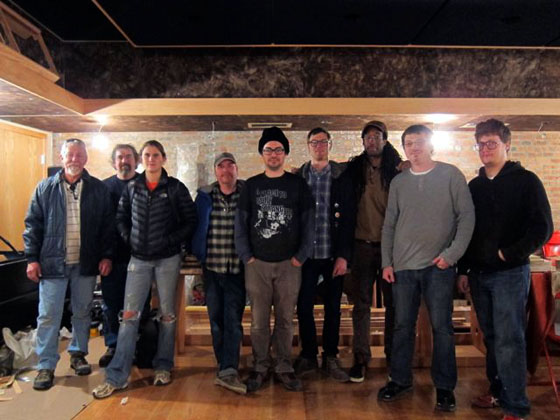Marc Alan Goodman’s Building Strange Weather Blog: Strange Weather VI Opens!
The final installment of the “Building Strange Weather Blog” series by producer/engineer and studio owner Marc Alan Goodman. Click to start at Step 1: Finding A New Home; #2: Design; #3: Waiting For Permits (Part 1) and #4: (Part 2); and #5: Stops & Starts, #6: Demolition, #7: The Structural Work, #8 The Joys of Home Ownership, #9 Rain, Rain, Rain, #10 A Control Room Is Born, #11 Plumbing Inspections aka More Delays, #12 The Timing Game, #13 Framing & Wiring, #14 Sheetrock, Soffits & A Race To The Finish and #15 Everything Else.
WILLIAMSBURG: The month of November 2012 was a whirlwind the likes of which I’ve never experienced. Most nights consisted of about four to five hours of sleep, followed by an immediate return to the studio. Here’s how it went…
When we left off last time Tony Brett and the Brett Acoustics crew were days away from coming back up from North Carolina to finish the space and build all of the acoustical treatments. Just before their arrival, Hurricane Sandy hit New York and changed everybody’s plans. We were extremely lucky in that our studio is located up on top of a hill, so damage-wise it wasn’t much worse than any other large rainstorm. However I’d bet every New York engineer has at least one friend who lost everything in the floods, and the city itself was a madhouse.
First the roads through the city were closed, and then it was impossible to get gas for almost two weeks, which pushed our out-of-town crews back. We were able to delay our first week of sessions by about ten days, but the time lost wasn’t easy to make up.
When things finally started to clear up from the storm Tony was still working on finishing the racks and wall treatments in his shop, so the rest of his fully capable crew (Brian, Ray, and Tiffany) came and started work. First thing, they focused on building the back wall of the control room. From the back of the building we have a cinderblock wall, followed by a tuned membrane absorber trap, followed by a gap, a frame wall stuffed with standard loose-fill insulation and three layers of rigid fiberglass of varying densities, and wood slats in an absorptive / diffusive pattern designed specifically for the shape of the room.
The membrane absorber and frame wall went up relatively quickly, and once they were in, it was time to stuff the soffits with loose-fill insulation as well. Daniel and I made the trips to pick it up in the band Prince Rama‘s Astrovan, which was kindly loaned to us during the extremely stressful period of finishing construction. I don’t know what we would have done without it, and we owe those guys big time.
We filled the van to the ceiling with tightly packed insulation four or five times before we had thoroughly stuffed the soffits. It was a dirty day, which was followed by another day of Daniel laying on top of the control room ceiling (there’s about nine inches of clearance between the ceiling and the HVAC ducts above it) trying to stuff insulation on top of the machine room, which was supposed to have been done in advance but was apparently overlooked. For nearly two days every time I walked past the access hatch I could hear D’s iPhone blasting ODB. It must have been a serious party up there. Daniel had a pretty good cough for a week or so afterwards.
Next up, the crew started mounting the plastic clips to hold the fabric stretched over the soffits in place. This wasn’t an easy job, as the clips themselves need to be mounted at exactly the right height, or the fabric would show ripples stretching the length of the room when they tried to pull it in place. As Tony’s crew became fully engrossed in that world, Daniel and I headed upstairs to his spare bedroom and started on the studio’s wiring. Thom Canova came back up from North Carolina with his new and awesome assistant Hodge, plus we brought in our close friend and fantastic NYC tech Bevin Robinson to help us finish the job.
The five of us made a relatively short job out of stretching Techflex over thousands of feet of cable and then pinning ELCO connectors for the patchbay side. We decided to go with ELCO bays rather than hard-soldered for modularity in the future, and I couldn’t be happier with the result. Pulling an ELCO out of a wall covered with 78 of them and re-pinning it isn’t exactly a vacation, but it’s significantly easier than trying to de- and re-solder traditional bays.
If you’ve never used Techflex before and are getting ready to do an install I can’t recommend it more highly. It’s essentially a woven sheath that you stretch over the entire length of the cable. It keeps it from kinking, and is relatively slick, which means when you’re pulling cables through pipes or around corners together, the friction of their normally somewhat gummy exteriors doesn’t cause them to stick or catch. Getting the Techflex onto the cable isn’t exactly a fun job, and it had my tendonitis flaring up pretty hard by about ten minutes into the two or so days it took us, but later when we actually installed the cables it made our lives about ten thousand times easier.
By the time we made it back downstairs the crew there had just about finished putting up rigid fiberglass (we used mostly the stuff from Knauf, though it’s identical to the more ubiquitous Owens Corning 703 and 705 products) on the outside of all of the soffits, which meant they were prepared for fabric when the room could be properly cleaned out.
Next up was installing clips in the ceilings from which to hang the clouds. The clouds themselves were mainly built out of normal drop ceiling frames, with panels custom built by Tony and the guys in his shop. All they needed to do was hang the frames, cut holes for the light cans in the panels, and pop the pre-built panels in place. It was still a couple days of work, but it was a relatively low stress job as studio builds go.
While Ray and Tiffany managed that, Brian spent his time in the control room laying out the diffusive/absorptive pattern on all of the walls. The pattern itself is hard to describe, and is perhaps better seen in photographs, but when looking at it, try to remember that it’s three layers deeper than what’s visible.
Putting it up was an extremely time consuming process, and it had Brian and eventually Tony tied up for quite a number of days, during which the rest of us started putting XLR connectors on all of those cables that we’d run.
The control room consists of three separate credenzas for the rack gear, adding up to eleven racks in total. Each rack is 14 spaces, and has dedicated 16 channel input and output snakes. On top of that each one of the credenzas has 16 dedicated tie-lines to connect outside engineers’ gear. That’s a total of 448 XLR connectors for the rack gear alone.
The console itself, being designed for modular studio use, also has XLR and TRS connectors rather than the more traditional ELCOs. At seven per channel, that meant another 336 for the bulk of the desk plus at least 45 or so for the master section. All in all it was a lot of connectors to solder, and we had our heads down for quite a while trying to complete it.
From that point on the timeline gets a bit hazy for me. My sleep fell from about five hours per night to about three, and the solder fumes and anxiety finally started to get to me, but somehow during that period we were able to finish the wall treatments, run all of the cabling, hang the clouds, and clean the place up enough to start hanging fabric on the walls and ceiling.
A last minute catch by Wes [Lachot]– due to a picture on our photoblog – led us to repaint the front wall of the control room black. It ended up being a far better look.
The electricians were a bit of trouble, if only because they must have vastly underestimated the job and were stretched thin due to the amount of work the city needed rebuilding after Hurricane Sandy. Every contractor I spoke to had ten times their normal workload, much of it in parts of town they normally wouldn’t travel to or out on Long Island, and the electricians were no exception. In the end they finished their work in time, if barely, and we had power and lights in time to open our doors on December 9th.
The night before we started our first project in the new space, the new Total Slacker LP, I was able to get just under two hours of sleep. The session didn’t start until one in the afternoon and I was still laying on the floor plugging gear into the racks when they showed up, but the moment we set up the first mics, I was astounded.
I’ve never even worked in a space where recording music is so effortless. Not only does the live room sound fantastic, but the control room is so honest that I find myself making decisions without having to second guess. We’ve been using the one pair of monitors, which are soffit-mounted Dynaudio M3As, without any need for nearfields or other references, and have already been doing some of the best work of our careers.
I seriously can’t give enough thanks to everyone who made this all possible, from my wife Brigitte and business partner – the inevitable Daniel James Schlett – to Wes Lachot who saw a dilapidated chiropractors office and knew the studio it could become… to Tony Brett along with Brian, Ray, Tiffany, and Frosty who are without a doubt the finest carpenters I’ve ever worked with, not to mention some of the best people I’ve ever met… to Thom Canova and his assistants Dominic and Hodge, as well as Bevin Robinson, whose technical skills and sardonic wit made an impossible wiring job a reality… to Nick Gangone and his crew who took what should have been a condemned building and made it into a place where I can happy live and work for the rest of my life…to Vinnie Napolitano and his crew including Paul Gomez, who handled the extremely difficult job of running a low noise electrical system while simultaneously putting up with our unusual requests… to Roland and his crew who installed a HVAC system way outside of their traditional specifications which is functioning beautifully… to Bruce Merdjan who designed that system as well as the structural plans which saved the building… to Hannah Purdy, architect and Alexis at CODE who dealt with the impossible NYC Department of Buildings on my behalf… to Dave and Janice at SonicScoop for putting up with my sporadic attempts at the English language… to my family who’s support and understanding have made my entire life possible not to mention this project… and to my neighbors, who have been very kind to a new neighbor who went through two-and-a-half years of construction just to bring more noisy musicians to the block.
Click to see more photos of the process over on our photoblog!
– Marc Alan Goodman
strangeweathersound [at] gmail dot com
http://strangeweatherbrooklyn.com
Marc Alan Goodman is a producer/engineer who’s worked with artists such as Jolie Holland, Marc Ribot, Shudder to Think, Dub Trio, Normal Love, Alfonso Velez, Angel Deradoorian and Pink Skull.
Please note: When you buy products through links on this page, we may earn an affiliate commission.







